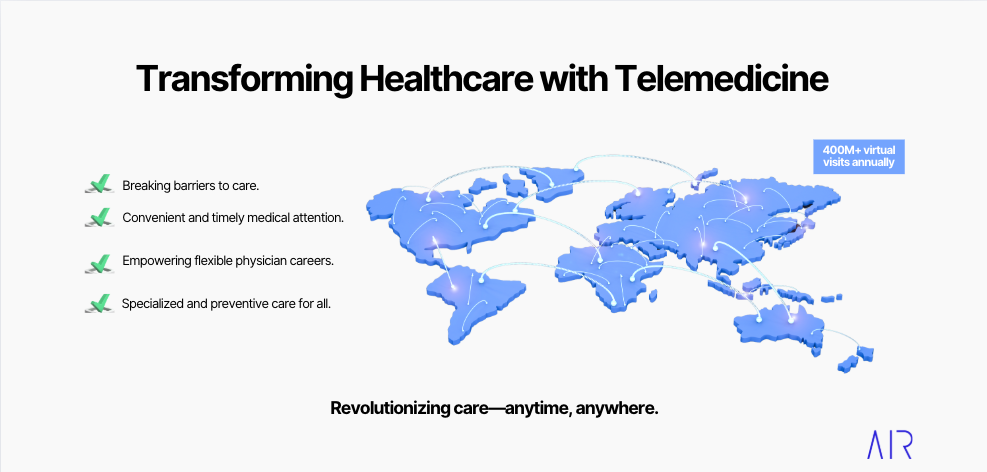.png?width=2000&height=600&name=Mindset%20(4).png)
There has been a problem with Learn, please contact the administrator of the academy. Error code: 126692f2-e927-4bf7-b621-e4fd56a48320.
There has been a problem with Learn, please contact the administrator of the academy. Error code: 4b82b286-38b2-4212-9cdd-3b024873e7b9.

Telemedicine is revolutionizing healthcare by breaking down barriers to access, especially for patients in underserved or remote areas. With over 400 million virtual visits annually, it’s clear that this is not just a trend but a vital shift in how care is delivered. It empowers physicians to create flexible, fulfilling careers while offering patients personalized, convenient, and timely medical attention. By leveraging technology, telemedicine addresses critical gaps in traditional healthcare systems and opens up new opportunities for specialized and preventive care. This evolution is transforming lives, making healthcare more inclusive, efficient, and adaptable to modern needs.
In this course, you'll learn how to get started in telemedicine. From understanding its importance in addressing healthcare gaps to setting up your own telemedicine services, this course provides actionable insights and practical tools. You'll explore real-world success stories, identify lucrative opportunities, and gain access to essential resources like checklists, worksheets, and expert videos to confidently navigate the telemedicine landscape. By the end, you'll be equipped to build a flexible, rewarding telemedicine career tailored to your goals.
Opportunities in Telemedicine
Telemedicine is unlocking new horizons for healthcare professionals, allowing you to extend your reach beyond traditional boundaries. Whether you're seeking greater flexibility, a new specialty focus, or the chance to serve underserved communities, telemedicine offers a wealth of possibilities. Here's where you can make a significant impact:
- Primary Care: Serve patients in healthcare deserts.
- Specialized Clinics: Focus on chronic conditions, mental health, or niche specialties.
- Virtual Urgent Care/ER: Adapt critical skills to a virtual setting.
- Concierge Practices: Build a personalized patient panel in your state.
Entering the telemedicine field requires a well-informed approach to maximize success. Start by researching demand in your specialty to align your services with real needs. Understand the licensing requirements for practicing across states, leveraging tools like the Interstate Medical Licensure Compact. Finally, explore telemedicine platforms and emerging niches to find the best fit for your expertise and stay ahead of industry trends.
Here's how to get started:
- Research Demand for Your Specialty: Assess where your skills are needed most. Look into current healthcare trends, identify gaps in service delivery, and determine the patient populations that could benefit from your expertise. This will help you tailor your services to meet real needs.
- Learn the Licensing Requirements for Cross-State Practice: Navigate the legal landscape with confidence. Each state has unique regulations governing telemedicine. Familiarize yourself with the Interstate Medical Licensure Compact and consider obtaining licenses in multiple states if you plan to expand your reach.
- Investigate Telemedicine Platforms and Emerging Niches: Find the right platform to showcase your services. Research various telemedicine providers to understand their patient base, technological capabilities, and support systems. Stay informed about emerging niches, such as tele-rehabilitation or remote patient monitoring, to position yourself at the forefront of innovation.
Benefits of Telemedicine
Telemedicine has transformed healthcare by increasing access, improving efficiency, reducing costs, and enhancing patient engagement. Below are the key benefits for both providers and patients.
1. Increased Access to Care
- Expands access to healthcare for patients in rural or underserved areas who may have limited options for in-person visits.
- Provides convenience for patients with mobility challenges, chronic illnesses, or transportation barriers.
- Increases availability of specialists, reducing long wait times and improving coordination of care.
2. Improved Provider Efficiency and Work-Life Balance
- Allows for more flexible scheduling, enabling providers to see patients at times that work best for them.
- Reduces no-show rates, as patients are more likely to attend virtual appointments.
- Decreases administrative burdens related to in-office logistics, allowing providers to focus more on patient care.
3. Cost Savings for Providers and Patients
- Lowers overhead costs for providers by reducing expenses related to office space, staff, and utilities.
- Reduces unnecessary emergency room and urgent care visits by offering virtual consultations for non-emergency conditions.
- Saves patients money on travel, childcare, and time away from work by allowing them to attend appointments from home.
4. Enhanced Patient Engagement and Satisfaction
- Makes follow-ups easier, increasing patient adherence to treatment plans.
- Provides a more direct and focused communication experience, free from the distractions of a busy office setting.
- Improves patient retention, as the convenience of telemedicine leads to greater satisfaction and continued care.
5. Better Chronic Disease and Preventive Care Management
- Enables remote monitoring for chronic conditions such as hypertension, diabetes, and heart disease, reducing complications and hospitalizations.
- Encourages patients to be more proactive about their health, increasing participation in preventive screenings and wellness checkups.
- Allows for quicker interventions when health trends indicate potential risks.
6. Expanded Provider Reach and Revenue Opportunities
- Allows providers to see patients in multiple states if they hold the appropriate licenses, broadening their practice reach.
- Supports specialty care, enabling providers with niche expertise to connect with patients beyond their local area.
- Creates opportunities for new revenue streams, including second-opinion services, subscription-based care, and remote consultation models.
7. Improved Public Health and Infection Control
- Reduces the spread of infectious diseases by keeping sick patients out of waiting rooms and emergency departments.
- Expands access to behavioral and mental health care, making it easier for patients to receive therapy and psychiatric care.
- Supports rapid response during public health emergencies, such as pandemics, natural disasters, and medical crises.
8. Greater Flexibility for Both Patients and Providers
- Shortens appointment wait times by reducing logistical barriers that delay care.
- Eliminates transportation concerns for patients without reliable access to a vehicle or public transit.
- Gives providers more control over their schedules, reducing burnout associated with high-volume in-person practice.
9. Integration with Digital Health Tools and Artificial Intelligence
- Enables remote monitoring through wearable devices and at-home diagnostic tools, providing continuous health tracking.
- Uses AI-driven automation for administrative tasks, improving efficiency in scheduling, triage, and follow-up communications.
- Enhances data insights by integrating with electronic health records, allowing providers to track trends, flag risks, and optimize treatment plans.
10. Increased Continuity of Care and Collaboration
- Improves communication between primary care providers and specialists through shared digital records and virtual consults.
- Reduces care fragmentation by ensuring that patient history, test results, and treatment plans are easily accessible.
- Strengthens care coordination, especially for patients with complex medical needs requiring multiple providers.
Physician burnout is a well-documented challenge—with studies showing that over 40% of physicians report high levels of stress and exhaustion from administrative overload and long hours. For a physician just starting in telemedicine, there are concrete steps you can take to counter these issues and build a more sustainable practice.
Specific Strategies to Reduce Burnout with Telemedicine
-
Streamline Administrative Tasks
- Automated Documentation: Choose a telemedicine platform that integrates seamlessly with your electronic health record (EHR). Automated note-taking and data entry can cut down on manual work and free up valuable time.
- Smart Scheduling: Utilize scheduling tools that automatically manage appointments, send reminders, and handle follow-ups to reduce the burden of manual scheduling.
-
Establish Predictable, Flexible Hours
- Defined Virtual Hours: Set clear time blocks for virtual consultations. For example, allocate specific morning and afternoon sessions exclusively for telemedicine, reducing the need for after-hours charting.
- Built-In Breaks: Schedule short breaks between appointments to decompress and prepare for the next session, which can help maintain focus and energy.
-
Optimize Patient Interaction
- Focused Consultations: Use virtual visits to concentrate on key patient issues. This focused approach minimizes the distractions and interruptions common in busy clinical settings.
- Hybrid Care Models: Consider reserving in-person visits for cases that truly require physical examination, while managing routine follow-ups and consultations virtually. This balance can improve efficiency and lower overall stress.
-
Eliminate Commuting and Office Distractions
- Remote Work Benefits: By working from home or a location of your choice, you eliminate daily commutes and office politics. The extra time can be redirected toward self-care or refining your workflow.
Real-World Example
Consider Dr. Smith, a primary care physician who recently shifted to a telemedicine-first model. By integrating automated EHR tools and smart scheduling:
- Administrative workload dropped by 30%, freeing up time to focus on patient care.
- After-hours work decreased by 25%, thanks to clearly defined virtual hours.
- A hybrid model (three days virtual, two days in-person) maintained patient volume while significantly improving work-life balance and reducing burnout symptoms.
Hospitals, urgent care centers, and primary care practices are increasingly overwhelmed by high patient demand, extended wait times, and provider shortages. Telemedicine serves as a critical pressure-release valve by diverting non-urgent cases, improving triage accuracy, and reducing unnecessary hospital admissions.
Key Benefits
-
Emergency Room Diversion
• Telemedicine platforms conduct real-time virtual triage to assess non-emergency cases.
• Patients are redirected to urgent care, pharmacies, or provided with self-care advice, preserving ER capacity for critical cases. -
Reducing Hospital Readmissions
• Remote patient monitoring (RPM) and virtual follow-ups enable early intervention.
• Continuous monitoring helps prevent complications and avoidable rehospitalizations. -
Primary Care Load Balancing
• Routine follow-ups, medication management, and chronic disease check-ins are efficiently handled via virtual visits.
• This frees up in-office appointments for urgent or complex cases. -
Scalable Crisis Response
• Telemedicine platforms can rapidly expand during crises such as pandemics or disaster relief efforts.
• This scalability prevents physical facilities from becoming overwhelmed.
Case Study
A regional health system implemented a tele-triage solution specifically for emergency room patients. Over six months, non-emergency ER visits dropped by 30%. Virtual consultations successfully redirected patients to appropriate care settings, resulting in significant cost savings and faster emergency response times.
Activity: Define Your Initial Goal
Download the "Goal Setting Worksheet.pdf" and follow these steps.
- Career Goals
- What type of telemedicine do you want to practice?
- How much time will you dedicate to it?
- Will you transition fully or balance telemedicine with brick-and-mortar roles?
- Financial Goals
- What is your monthly income target?
- How many hours you want to work?
- Plan for licensure costs and platform fees.
- Personal Goals
- List your priorities (family, hobbies, health).
- Decide how telemedicine can help achieve a work-life balance.
- Set clear boundaries for work hours.
Telemedicine Quick Start Checklist
Starting your telemedicine practice requires more than just technology—it demands careful planning, legal compliance, and a structured workflow to ensure smooth virtual visits. This checklist serves as a practical guide to help you navigate licensing, security, patient engagement, and operational best practices. Whether you are transitioning from in-person care or expanding your services, this resource will help you set up a compliant, efficient, and patient-friendly telemedicine practice from day one.
5-Step Guide to Becoming a Telemedicine Entrepreneur
Transform your telemedicine career into a thriving business with our 5-Step Guide to Telemedicine Entrepreneurship. This powerful resource goes beyond practicing medicine—it empowers you to build, scale, and lead your own telemedicine business. Learn how to define clear entrepreneurial goals, navigate licensing, establish robust infrastructure, choose the right platforms, and create a winning patient engagement strategy.
Download it today and take the first step toward becoming a successful telemedicine entrepreneur!
-1.jpg?width=1000&height=250&name=AIR%20Launch%20Panoramic%20Photos%20(2)-1.jpg)
Key Takeaways: Importance of Telemedicine
-
Revolutionizing Access to Care: Telemedicine breaks down barriers to healthcare, connecting patients in underserved and remote areas with quality medical services.
-
Empowering Physicians: It offers unmatched flexibility, allowing healthcare providers to design careers that align with their personal and professional goals while expanding their reach to new patient populations.
-
Meeting Modern Healthcare Needs: With over 400 million virtual visits annually, telemedicine addresses critical gaps in traditional systems, providing timely, convenient, and efficient care.
-
Growing Opportunities: The demand for telemedicine is increasing, offering diverse pathways for primary care, specialty services, and niche practices.
-
Transforming Lives: By leveraging technology, telemedicine makes healthcare more inclusive and adaptable, ensuring better outcomes for both patients and providers.
Telemedicine is not just a trend—it’s a vital evolution in healthcare that enhances access, improves efficiency, and empowers physicians to create sustainable and fulfilling practices. This course equips you with the foundational knowledge to start your journey and make a meaningful impact in the telemedicine space.

RESULT:
Approved
Your score:
Here’s your quiz result! Thank you for completing the quiz. Your effort in testing your knowledge is valuable. Whether you nailed it or learned something new, this quiz is a step forward in your understanding of telemedicine. Keep up the great work and continue building on your knowledge!
Great job! Your performance shows a strong understanding of telemedicine concepts. Keep applying what you’ve learned and exploring deeper insights to further enhance your expertise. Well done!

RESULT:
Reprobate
Your score:
Here’s your quiz result! Thank you for completing the quiz. Your effort in testing your knowledge is valuable. Whether you nailed it or learned something new, this quiz is a step forward in your understanding of telemedicine. Keep up the great work and continue building on your knowledge!
Don’t be discouraged! Use this as an opportunity to review the course materials and identify areas for growth. With practice and persistence, you’ll gain a stronger understanding of telemedicine and its importance. Keep going—you’ve got this!
Knowledge Check
This is your opportunity to test your understanding of the key concepts and importance of telemedicine. Take your time, read each question carefully, and answer to the best of your ability. Remember, this quiz is designed to help you learn and grow, so do your best and enjoy the process!